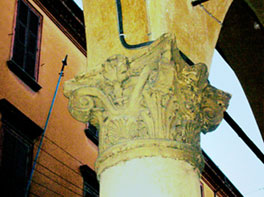|



 |
This "scenographic" city (a real theatre with porticoes,
squares, perspectives) gave birth to the Bibiena family, the most renown
theatre builders and stage designers ofthe European Baroque period.
It was not by chance that the ten Bibiena, that is
to say the stage designers and theatre builders who, from the 16th to the
171hCentury, worked in Italy and all over Europe, started in a city like
Bologna. They were inspired not only by the specific local
tradition (the architects of
the late 16th century and the Carrace school which was devoted to
scenography), but also by the influence of the
urban setting. The Municipal Theatre, built by
Antonio Bibiena, was inaugurated in 1763 with a performance in
which both the scenery and the costumes had been created by him. The
internal structure of the theatre, the well known
"courbe phonique" with the several rows of boxes, one above the other
typical of the Baroque theatre, was in fact made known and popularised by
the Bibiena (the "palchetto" -boxes-already used in 1638 at the Teatro La
Scala, were a Bolognese invention). Today too, and particularly
at night, the city transforms into a stage. Full of
lighting effects, scenes and wings, thus revealing its theatrical
character emphasised by the Baroque interiors of the buildings. There are
also in the different centres of the Bolognese province sumptuous theatres
and little theatres: in Budrio, in Crevalcore, in Imola, in Pieve di
Cento, in St. Giovanni in Persiceto. |
|
b
o
l
o
g
n
a
u
r
b
a
n
s
e
t
t
i
n
g
|
